Buttersworthless?
A quick brush through art fraud.

A quick brush through art fraud.
‘Sold!’ cried the auctioneer, while you, a jubilant buyer beam proudly at the latest painting you have added into your collection.
A painting commissioned to Buttersworth by the East India Company, it depicts a ship on a vast sea. Clouds frame it, with a distant moon shedding light on the whole scene. It was breathtaking, and a source of great admiration for your friends. Until a chance comment by a visitor to your gallery led you to check if it truly was an original. Imagine your shock at hearing the truth!
You can stamp your foot all you want, but reality remains the same — you are yet another victim of art fraud.
Art fraud has been around for much longer than the fake Buttersworths and Picassos that we know about today. Take the case of Michelangelo.
With the Renaissance came in the era of Humanism, wherein people began to lay importance in earthly matters, as opposed to divine. This also ushered in a demand for artwork by then-famous artists.
The churches were no exception to this, and that was why a cardinal bought a beautiful carving of a sleeping Cupid, believing it to be an antique. Turns out, as the apoplectic cardinal later discovered, it was actually a sculpture which had been buried in mud to artificially age it. The carver was not an ancient artist: it was someone rather new to the scene; a young man who went by the name of Michelangelo.
This incident only added to his fame: after all, the begrudgingly impressed cardinal did allow him to keep a share of his proceeds. Michelangelo eventually turned over a new leaf, however. He went on to sell his own work, and amassed so much fame, that people are now creating forgeries of his pieces.
Art fraud is defined as the deliberately false representation of the artist, age or ownership of a piece of artwork in order to financially benefit from it. This means that art fraud is not only limited to forgery, which is what many people tend to assume art fraud is. It also includes false dating — like claiming a statue is from a particular dynasty — or theft for resale.
Carrying out art fraud means taking into consideration a whole host of things. The replicas need to be exact enough to pass the keen eyes of an art authenticator. This means that everything needs to appear true to its time, from the fabric painted on, to the paints used itself.
Ken Perenyi, a master forger, takes immense pride in his copies. All of his work begins with an impressive amount of research, to really embody the artist he is copying. He familiarises himself with every aspect of the artists work — from the canvas they may have preferred, to the frames they may have used. While emulating 18th-century artists, for instance, Perenyi uses canvas from India and China, as they have similar irregularities as the cloth used back then. He uses salt water to create convincing rust stains, and other techniques to fake stamps, chalk marks, and other inventory labels.
Perenyi’s research runs so deep that he even managed to recreate antique varnish. Antique being a keyword here, because this kind of varnish tends to cast a greenish glow in UV light. The master fraudster would carefully scrape varnish from paintings from the same era, strain it through a sieve, and mix it with modern varnish so it would glow convincingly. There was a small catch though: antique varnish used sugar, which attracted flies. Years later, fly droppings would turn brown, and speckle the painting.
Perenyi managed to recreate those ancient fly droppings too, with some epoxy glue, and brown paint.
His works have been auctioned and sold by many esteemed companies like Sothebys. So brilliant was his work that, despite creating forgeries for over thirty years, and undergoing a five year long FBI investigation, he was never arrested. That seems viable: after all, he did manage to con some big art galleries! Much like Michealangelo, however, Perenyi too has turned over for the better — and sells his work as copies now.
Other methods are used by forgers to convincingly age paintings. They can range from holding hair dryers over paintings, to baking it, as Wolfgang Beltracchi did. Beltracchi and his wife would also collect dust from antique frames, and sprinkle them over their paintings. But it doesn’t end there: so committed were they that they even faked photos from the 1930s with his forged painting in the background, claiming that they belonged to his wife, Helene’s, grandparents.
Beltracchi’s career didn’t end as well as Perenyi’s did. The former was eventually caught — for using the wrong pigments! His use of titanium white in a copy of Dutch painter Heinrich Campendonk’s work ultimately exposed him, for the pigment was not in use when the artist was alive.
The other day, I was scrolling through YouTube, trying to find something interesting to watch when I came across a video called "i did art fraud to prove a point". Side note: It's by the Answer in Progress team, who are my favourite people on the internet at the moment so I’d highly recommend you check them out! But I digress.
The video really got me thinking. Not only about the act itself, but about the moralities of it. What drives people to copy other’s work?
Most crimes have some root cause, a systemic failure that drives people to figure things out themselves. Many artists, as in Perenyi’s case, resort to fraud because they are unable to find a market to sell their original work in. This is because even within the demand for art, there is more esteem given to the artists, and not the art itself.
In today’s world, there is a lot of emphasis placed on productivity. Every skill, to a certain extent, is only considered valuable if it benefits us financially. Therefore, art isn’t really seen as productive work. This is a far cry from the way things were before. Rulers would become patrons of artists, and support them financially, therefore allowing more and more people to express their skill.
Not that it justifies conning people. The crime part comes in because a painting is sold as something else of higher value. Do I understand that it is a crime? Yes. Do I still find the entire affair hilarious? Absolutely.
See, art fraud only affects the ultra-wealthy. Those who can afford to spend millions on a singular painting, only for it to be shut up in warehouses, or accessible exclusively to their inner circles. It’s hard to feel much sympathy for them: you’d think that they would be happy regardless, because they technically bought what they were asking for.
Sure, it’s an antique painting in a certain distinctive style — just without the years of moulding. Oh, and bonus: this newer piece would probably even last longer! So it’s no surprise that I usually come away from stories of art fraud appreciating the artists who manage to fool so many experts.
But that also raises the question: how can I argue that only art fraud is justifiable, and not other kinds of frauds? It is still a crime to falsely advertise a product. In fact, when I scale it down to my everyday realities, I tend to be rather hypocritical of the matter. Of course I would be affronted if I was sold, say, fake merchandise from a singer I admire, or fake shoes from a brand I respect.
I could go on forever, arguing for and against, but I will stop here, and leave the rest to you.
Art fraud isn’t limited to just paintings, no. Picture this: you, a rich capitalist, are looking for something to buy; preferably something that will add to your prestige. You hear of an interesting item on sale: the Taj Mahal. Perfect, you think, that sounds like a great addition to your collection. You meet the seller, a well dressed, intelligent man. A few hours and several negotiations later, you walk away satisfied.
The Taj Mahal is yours.
Except it’s not: it’s still very much the UNESCO heritage site it has been. There may be disagreements about whether it rightfully belongs to the Indian government, the Archaeological Survey of India, or the local wakf board, but, whoever the owner is, it’s certainly not you. Meanwhile, the businessman sits back in his chair, whipping off his fake beard. Another good day; another successful swindle.
This infamous conman, one of India’s most notorious in the 90s, was Natwarlal. Born Mithilesh Kumar Srivastava, and a lawyer by profession, Natwarlal eventually decided he was better off breaking the law, not defending it. His descent to crime began when he realised that he had a knack for forging signatures, a skill he put to use by stealing around Rs 1000 from his neighbour’s bank account. He soon moved on to forging cheques and release orders from the Railway Authorities, vanishing with the goods.
Eventually, he began to target the rich. Natwarlal supposedly sold the Taj Mahal, Rashrapathi Bhavan, Red Fort and the Parliament House of India (members included!) — not just once, but multiple times. He had over a hundred cases on him, and was sentenced to roughly the same number of years in prison. He however only served twenty, having escaped jail seven times.
Much of this story sounds like a Bollywood movie (it eventually became one too) and over time, his story only gained popularity. He portrayed himself as a Robin Hood of sorts, claiming that he robbed rich capitalists only, and distributed his money to the poor, often holding feasts for them. This, coupled with the non-violent nature of his crimes made him quite famous. Natwarlal passed away in 2009 (unless he was cremated in 1996, as his brother claims).
Fraudsters aside, though, there’s another completely different lens through which we can tackle the problem.
It is a popular pastime of many: drawing out scenes from one’s favourite book, movie or any form of media. I’m talking, of course, about fanart. And with the rise of bots on social media platforms, there is a new kind of art fraud that is on the rise: drawings on t-shirts.
There seems to be a growth of plagiarism on the internet, especially on social media platforms like Twitter. Enthusiastic fans comment that they would love to see their favourite artist’s work on a t-shirt. The artists notice, of course; but so do bots! Bots, who then plagiarise the art, put it on a shirt, and paste the link everywhere leading many to believe that it is official. It then becomes a nightmare for the artists, as they try to take it down.
Modern problems require modern solutions, and the art community worldwide is fighting back. Many post messages like ‘this website plagiarises artwork’ and request people to comment that they want it on a shirt. The bots pick it up, and voila! Everyone on the website can see that it is stolen art.
Michelangelo eventually began to sell original work. Perenyi now officially sells his work as “copies” of famous artists, so buyers know exactly what they’re getting. Beltracchi too, while serving his sentence, collaborated with a photographer friend and produced many (original) mixed-media pieces. Perhaps art fraud only helps to improve one’s character: after all one could say that they painted over a new leaf!
